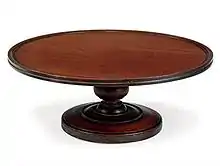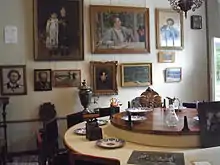Lazy Susan
A lazy Susan also known as "lazy Sally" is a turntable (rotating tray) placed on a table or countertop to aid in distributing food. Lazy Susans may be made from a variety of materials but are usually glass, wood, or plastic. They are circular and placed in the centre of a table to share dishes easily among diners. Although they are common in Chinese restaurants, the lazy Susan is a Western invention.[1] Owing to the nature of Chinese cuisine, especially dim sum, they are common at formal Chinese restaurants both in mainland China and abroad. In Chinese, they are known as 餐桌转盘 (t. 餐桌轉盤) (p cānzhuō zhuànpán) or "dinner-table turntables".

History
It is likely that the explanation of the term lazy Susan has been lost to history.[2][3][4] Folk etymologies claim it as an American invention. According to lore, Thomas Jefferson invented the device, which was known as a "dumbwaiter" for his daughter Susan. Regardless of the origins of the name, by 1917 it was advertised in Vanity Fair[5] as "Ovington's $8.50 mahogany 'Revolving Server or Lazy Susan'"[6] but the term's use predates both the advertisement and, probably, the country.[2][4]

Part of the mystery arises from the variety of devices that were grouped under the term "dumb waiter" (today written dumbwaiter). An early 18th-century British article in The Gentleman's Magazine describes how silent machines had replaced garrulous servants at some tables[7] and, by the 1750s, Christopher Smart was praising the "foreign" but discreet devices in verse.[8] It is, however, almost certain that the devices under discussion were wheeled serving trays similar to those introduced by Thomas Jefferson to the United States from France,[9] where they were known as étagères.[9] At some point during or before the 3rd quarter of the 18th century, the name dumb waiter also began to be applied to rotating trays.[2] (Jefferson never had a lazy Susan at Monticello, but he did construct a box-shaped rotating book stand and, as part of serving "in the French style", employed a revolving dining-room door whose reverse side supported a number of shelves.[10]). By the 1840s, Americans were applying the term to small lifts carrying food between floors as well.[2] The success of George W. Cannon's 1887 mechanical dumbwaiter popularised this usage, replacing the previous meanings of "dumbwaiter".
The lazy Susan was initially uncommon enough in the United States for the utopianist Oneida Community to be credited with its invention. They employed the devices as part of their practice of communalism, making food easily and equally available to residents and visitors at meals.[11] An American patent was issued in 1891 to Elizabeth Howell for "certain new and useful Improvements in Self-Waiting Tables". Howell's device ran more smoothly and did not permit bread crumbs to fall into the space between the lazy Susan and the table.[12]

Despite various folk etymologies linking the name to Jefferson and Edison's daughters, the earliest use of these "serviettes" or "butler's assistants"[14] being called a lazy Susan dates to the 1903 Boston Journal:
John B. Laurie, as the resuscitator of "Lazy Susan", seems destined to leap into fortune as an individual worker. "Lazy Susan" is a step toward solving the ever-vexing servant problem. She can be seen, but not heard, nor can she hear, she simply minds her business and carries out your orders in a jiffy.
Laurie was a Scottish carpenter who made his "lazy Susan" to the personal specifications of a Hingham-area woman. Unfortunately he presented this gift to her too late, which caused her to unleash an abusive tirade upon Laurie. When she finally asked him for the price, he "told her it wasn't for sale, though of course it is".[15] The name was repeated in a 1911 Idaho Statesman article – which describes it as "a cousin to the 'curate's assistant', as the English muffin stand is called"[16] – and again in the 1912 Christian Science Monitor, which calls the "silver" lazy Susan "the characteristic feature of the self-serving dinner table".[17] By the next year, the Lima Daily News described an Ohioan "inaugurat[ing] ... the 'Lazy Susan' method of serving".[18] Henry Ford used an enormous one on his camping trips in the 1920s to avoid bringing a full contingent of servants along with his guests.[4] In 1933, the term was added to the Webster's Dictionary.[19]
Unusually, the 1916 American Cookery describes the device as a German invention:[20]
There is a table arrangement used much in Germany, which has now found its way to America, though it is still by no means common. The German frau calls it "Lazy Susan", but it is entirely different from our product used for salt and pepper shakers. Its only point of similarity is the swivel upon which it turns. The one which joys my heart is of mahogany, and it turns automatically at the slightest touch. It contains seven china dishes, six of which are trapezoids, the center one being octagonal. The trapezoids fit about the center octagon, forming a perfect whole.
By 1918, Century Magazine was already describing the lazy Susan as out of fashion,[21] but beginning in the 1950s its popularity soared once again after the redesign and reintroduction of the lazy Susan by George Hall, an engineer, soy-sauce manufacturer, and partner in popular San Francisco-area Chinese restaurants (Johnny Kan's and Ming's of Palo Alto), and the rotating tray became ubiquitous in Chinese restaurants and was used in homes around the globe.[22] The decline in America's domestic service sector after World War I and its collapse following World War II,[23] combined with the post-war Baby Boom, led to a great demand for them in US households across the country in the 1950s and 1960s. This popularity has had the effect, however, of making them seem kitsch in subsequent decades.[4]
Other uses
The term is infrequently used for the much older turntables employed in pottery wheels and related tasks like sculpture, modeling, repair work, etc.[24]
See also
References
- Gross, Daniel."The Lazy Susan, the Classic Centrepiece of Chinese Restaurants, Is Neither Classic nor Chinese." Smithsonian Magazine. https://www.smithsonianmag.com/arts-culture/lazy-susan-classic-centerpiece-chinese-restaurants-neither-classic-nor-chinese-180949844/.
- Quinion, Michael. World Wide Words: "lazy Susan". 24 Apr 2010. Accessed 11 Aug 2013.
- Lazy Susan. "What’s in a name? The origins of Lazy Susan". 27 Sep 2010. Accessed 11 Aug 2013.
- Levine, Bettijane. The Los Angeles Times. L.A. at Home. "Back Story: Who Was Susan, and Was She Truly Lazy?" 25 Mar 2010. Accessed 15 May 2013.
- Vanity Fair, Vol. 9, No. 6. Dec 1917
- Klages, Karen. Chicago Tribune. "Whaddayaknow. Q: Who named the Lazy Susan?" 9 Jun 1996. Accessed 11 Aug 2013.
- Weekly Register, No. 105. 15 Apr 1732. Op. cit. The Gentleman's Magazine: Or, Monthly Intelligencer, "p. 701". F. Jefferies (London), Apr 1732. Accessed 11 Aug 2013.
- Smart, Christopher. Fables: "Mrs. Abigail and the Dumb Waiter: Fable XV". 1755.
- Monticello.org. "Rooms & Furnishings: Dumbwaiters". Accessed 11 Aug 2013.
- Monticello.org. "Design and Decor Convenience". Accessed 11 Aug 2013.
- Popik, Barry. The Big Apple. "Lazy Susan". 6 Sep 2009.
- Howell, Elizabeth (1891). Patent No. 464,073. Maryville, Missouri: United States Patent Office.
- Repin "Penaty" Estate in Repino/Kuokkala, Russia, currently a museum.
- The Unpopular Review. Holt. Jan 1919. p. 73. (Op. cit. Popik (2009).)
- Boston Journal, p. 3. "Hingham Indian Maidens Revive Ancient Arts: Lazy Susan, Dumb Waitress". 8 Nov 1903. Op. cit. Popik (2009).
- Idaho Statesman, p. 5. "An Ideal Servant: 'Lazy Susan' Works Hard and Never Talks Back" 30 Oct 1911. Op. cit. Popik (2009).
- Christian Science Monitor. "Giving an Automatic Dinner". 25 Sep 1912. Op. cit. Quinion (2010).
- Lima Daily News. 31 Dec 1913. Op. cit. Quinion (2010).
- Orlando Sentinel. "A Turn Through History With The Lazy Susan". Accessed 15 May 2013.
- American Cookery, p. 105. Aug–Sep 1916. Op. cit. Popik (2009).
- Century Magazine, p. 396. Jan 1918. Accessed 11 Aug 2013.
- Smithsonian Magazine, The Lazy Susan, the Classic Centerpiece of Chinese Restaurants, Is Neither Classic nor Chinese.
- Graff, Daniel. The Electronic Encyclopedia of Chicago. "[www.encyclopedia.chicagohistory.org/pages/386.html Domestic Work and Workers]". Chicago Historical Society, 2005. Accessed 11 Aug 2013.
- U.S. Navy. Safety Center. "Fleet Readiness Center (FRC) East Uses Lazy Susan Design to Prevent Work Related Musculoskeletal Disorders". Archived 2009-08-22 at the Wayback Machine.
External links
 Media related to Lazy Susans at Wikimedia Commons
Media related to Lazy Susans at Wikimedia Commons
